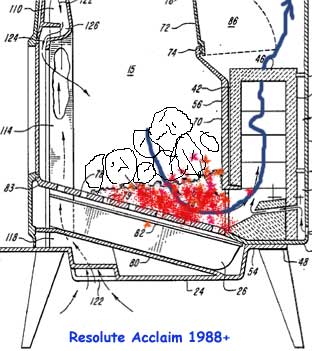here are my concerns with the Riteway bypass mode, it just doesn't seem to work sometimes ?
Re: Hitzer 75 Coal Stove.

By:
Bruce M On: Sat Mar 02, 2013 9:11 am
Rob R. wrote:Are you running the "direct damper" with the handle in the down position? (so the flue gasses go out the side of the firebox).
Hey Rob, I have been running my stove, very similar to this one, with the diverter handle in the up position. With it in the down position it diverts the hot gasses right out of the flue without the benefit of heating the mass of metal that the firebox is. I started doing this in the really cold days when I couldn't get enough heat out of the stove to keep up. I noticed my flue was really hot 300+,and the firebox was relatively cool mid 300's.
Now when I have the stove in the exact same setting and conditions but the handle in the up position, my flue temps go way down to 210* and my stove temps go up to 412*
That diverter never made any sense to me in that why would you want to let the hot gasses escape without the benefit of its heating, I'm really not sure as to why they even have it on the stove, can you or someone enlighten me on this, am I wrong in some way. Really has been puzzling me.
Re: Hitzer 75 Coal Stove.

By:
Bruce M On: Sun Mar 03, 2013 10:57 am
I decided to do a little study on my stove yesterday and my findings confirm that having this stove in the direct mode produces the most efficient burn in terms of extracting the heat from the fuel. I'm not trying to dispute what you fellas are saying to me about the proper function of this stove and others like it, just trying to settle things in my mind.
So here are the results. The stove was filled three hours prior to this test and all volatiles had been burnt off. The stove was at a stable temperature for an hour steady.
I started with the stove in the direct mode, handle up. The stove temp is 309* and stack is 163*. I then dropped the handle down to indirect mode. I did not open the door or adjust anything. I waited for an hour and a half and the stove temp was 280* and stack temp was 261*. As you can see I lost almost 30* in stove temp and gained 98* in stack temp. To confirm my findings I flipped the handle back up to direct mode and the temps quickly, in 30 mins, returned very close to the original temps.
It's curious to me as to the design of this indirect mode because as said earlier its forcing the gasses out the bottom, thus not allowing the hot gasses to pass by the bulk of the stove metal and warming it. The gasses just exit in the middle of the coal bed and right out to the flue, there is no extended path to take. It confirms to me anyway that in the indirect mode a lot of heat is escaping out of the flue without the benefit of its energy. Where am I wrong in this, please tell me, it's a bit puzzling to me.
Just for the record, my stove heats the house in either mode with no problems except when its single digits, then it struggles in the indirect mode to keep the house above 70* whereas in the direct mode it just cruises along on setting 3,1/4.
Re: Hitzer 75 Coal Stove.

By:
Bruce M On: Sun Mar 03, 2013 1:49 pm
LsFarm wrote:...
But an increase in flue temps HAS to be the result of a direct pathway from the fire to the flue..
More passageway=more surface to absorb heat=lower temps in the exhaust gasses..
Greg L..
And there in lies the problem. The so called indirect pathway is no more that closing the upper route and opening a route to the flue through the coal bed. What I am saying is that the air feeds from under the bed like any stove but instead of exhausting through the top the gasses now have a route right at mid depth of the coal bed. There is no extra passageway to force the exhaust up then down then up again, it just goes right on out.
Re: Hitzer 75 Coal Stove.

By:
Bruce M On: Sun Mar 03, 2013 6:19 pm
Yes as I understand it is a riteway clone. I actually thought the Hitzer 82 and also this model shared the same design, but now that you point this out maybe they are not the same internally. I did burn wood in it this past fall and will so this spring, but I honestly forget what position the handle was in when I burnt wood. i did not get any literature with this stove as far as the operation goes, I've just went by what I could pick up on this site. I think at this point a call to DS would be warranted to get the actual low down in the operation of this stove directly from the manufacturer.
Re: Hitzer 75 Coal Stove.

By:
samhill On: Mon Jan 06, 2014 11:25 am
I have a 75 in my garage that I burn wood in (not there enough for coal) but without any temp taking or measuring just going by what I experience BD is correct, I tried different control settings & I get more heat just by using the lever up position than by directing the draft lower & get longer burn times as well.
Re: Hitzer 75 Coal Stove.

By:
Bruce M On: Mon Jan 06, 2014 8:01 pm
Well since that post during last years burn season and that unscientific study I did I have been burning it in the direct exhaust configuration(arm up). I have to say this beast has zero issues in heating my home this way even with these extreme cold days that have been passing through. The heat is much more uniform also, in that I mean after I fill it in the evening and give it a couple hours to settle on a temp, it will stay at that temp through to the next day unless I decide to change the setting on the bi-metal stat. Like I said in another post, It may not be the most efficient stove out there but I'll never run out of enough thermostat to make things warm in the house.
Re: Hitzer 75 Coal Stove.

By:
EarthWindandFire On: Mon Jan 06, 2014 8:12 pm
I created this thread eighteen months ago, how come nobody ever told me to leave the handle in the UP position ???
Re: Hitzer 75 Coal Stove.

By:
Bruce M On: Mon Jan 06, 2014 8:17 pm






























































